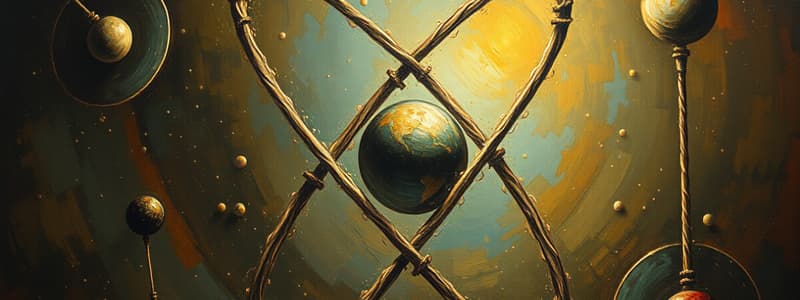Podcast
Questions and Answers
What is the basic unit of matter called?
What is the basic unit of matter called?
atom
Describe the nucleus of an atom.
Describe the nucleus of an atom.
Made up of protons and neutrons and is found in an atom.
What charge does the nucleus of an atom have?
What charge does the nucleus of an atom have?
- Negative
- Neutral
- Variable
- Positive (correct)
What charge does the electron cloud have?
What charge does the electron cloud have?
Why are atoms neutral despite having charged particles?
Why are atoms neutral despite having charged particles?
What is a chemical element?
What is a chemical element?
What does an element's atomic number represent?
What does an element's atomic number represent?
Atoms of the same element that differ in the number of neutrons they contain are known as what?
Atoms of the same element that differ in the number of neutrons they contain are known as what?
How are isotopes identified?
How are isotopes identified?
Why do all isotopes of an element have the same chemical properties?
Why do all isotopes of an element have the same chemical properties?
What is a chemical compound?
What is a chemical compound?
What does the formula for table salt indicate about the compound?
What does the formula for table salt indicate about the compound?
What holds atoms in compounds together?
What holds atoms in compounds together?
What are covalent bonds?
What are covalent bonds?
What are ionic bonds?
What are ionic bonds?
What is an ion?
What is an ion?
An atom that loses electrons has a negative charge.
An atom that loses electrons has a negative charge.
The structure that results when atoms are joined together by covalent bonds is called a what?
The structure that results when atoms are joined together by covalent bonds is called a what?
Which of the following statements is true about covalent bonds?
Which of the following statements is true about covalent bonds?
The slight attraction that develops between oppositely charged regions of nearby molecules is called what?
The slight attraction that develops between oppositely charged regions of nearby molecules is called what?
Flashcards are hidden until you start studying
Study Notes
The Nature of Matter
- The fundamental unit of matter is the atom.
- The nucleus of an atom consists of protons and neutrons.
- Protons carry a positive charge, while neutrons are neutral.
- Electrons, which are negatively charged, exist in a cloud surrounding the nucleus.
- Atoms maintain neutrality as they contain an equal number of protons and electrons, balancing their charges.
- A chemical element is defined as a pure substance composed of only one type of atom.
- An element’s atomic number denotes the count of protons and electrons it has.
- Isotopes are variants of the same element that differ in neutron count.
- Isotopes are identified through their mass number.
- All isotopes of an element exhibit the same chemical properties due to identical electron counts.
- A chemical compound results from the chemical combination of two or more different elements.
- The formula for table salt (NaCl) illustrates a 1:1 ratio of sodium to chlorine in the compound.
- Atoms within compounds are held together by chemical bonds.
- Covalent bonds involve the sharing of electrons between atoms.
- Ionic bonds occur when one or more electrons are transferred from one atom to another.
- An ion is defined as an atom with a net positive or negative charge.
- An atom that loses electrons carries a positive charge, not negative.
- A structure resulting from the joining of atoms via covalent bonds is referred to as a molecule.
- In a water molecule, each hydrogen atom forms a single covalent bond indicating shared electrons.
- Atoms can share up to six electrons, forming a triple bond.
- Van der Waals forces are weak attractions that arise between oppositely charged regions of nearby molecules.
Studying That Suits You
Use AI to generate personalized quizzes and flashcards to suit your learning preferences.




